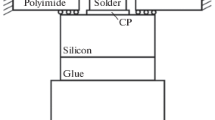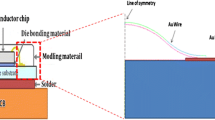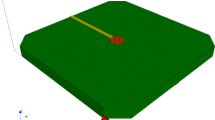Abstract
In order to ensure the operability, durability, and reliability of three-dimensional microelectronic modules, the engineering calculation of the structures, including the simulation of adhesive-bonded joints, as well as a valid choice of materials and constructive decisions, is necessary. The main operational and physical specifications for three-dimensional microelectronic modules and the advantages of the application of adhesive materials in the structures of modules are presented. It is established that the structural strength of three-dimensional microelectronic modules and the operating characteristics of adhesive-bonded joints depend on many factors. The most important factors among them are the properties of the adhesive material, the structure of the joints and the operating conditions. The types of loads, which affect the modules during their operation and their influence on the structural strength are considered. It is revealed that irregular loads, such as peeling and bending, are the most dangerous loading types for the adhesive-bonded joints of modules. It is established that in peeling a high concentration of edge stresses arises, which leads to the destruction of the joints, and in bending there is a concentration of normal and tangential stresses along the length of the glue lines. The types of adhesive materials which are used for assembling the modules are analyzed. The adhesive materials are selected taking the main design and technological constraints and the requirements on adhesive-bonded joints into account. The module’s structures are simulated and the influence of the physical, mechanical, and thermal properties of the adhesive materials on the stresses in the adhesive-bonded joints and the strength of the products under the impact of inertial loads with an acceleration of 1000g and heated by 40°С is determined. Recommendations on the simulation of adhesive-bonded joints of three-dimensional microelectronic modules are made. The obtained results revealed that the stresses depend on the elastic properties of the adhesive-bonded joints, as well as on the nature and value of the load on them, and they are determined by the mechanical strength and rigidity of the adhesive material. In order to reduce the stresses, it is necessary to use more rigid structural materials, and the adhesive materials need to be chosen based on the operating conditions of the microelectronic module.


Similar content being viewed by others
REFERENCES
Gus’kov, G.Ya., Blinov, G.A., and Gazarov, A.A., Montazh mikroelektronnoi apparatury (Mounting of Microelectronic Equipment), Moscow: Radio Svyaz’, 1986.
Grushevskii, A.M., Sborka i montazh mnogokristal’nykh mikromodulei: ucheb. posobie (Assembly and Mounting of Multichip Micromodules, The School-Book), Koledov, L.A., Ed., Moscow: MIET, 2003.
Pogalov, A.I., Blinov, G.A., and Chugunov, E.Yu., Stress-strain state and thermal burdening of multilayered adhesive bondings of multichip micromodules, Konstrukts. Kompoz. Mater., 2013, no. 2, pp. 18–22.
Huang, Y., Fan, C., Lin, Y., et al., Development of high throughput adhesive bonding scheme by wafer-level underfill for 3D die-to-interposer stacking with 30 µm-pitch micro interconnections, in Proceedings of the IEEE 65th Electronic Components and Technology Conference,2015, pp. 490–495.
Villenave, J.-J., Assemblage par collage, Paris: Dunod, 2002.
Kuznetsov, O.A., Pogalov, A.I., and Sergeev, V.S., Prochnost’ elementov mikroelektronnoi apparatury (The Strength of the Elements of Microelectronic Equipment), Moscow: Radio Svyaz’, 1990.
Pogalov, A.I., Blinov, G.A., and Chugunov, E.Yu., Structural strength and thermal mode of multichip modules, Izv. Vyssh. Uchebn. Zaved.,Elektron., 2017, vol. 22, no. 1, pp. 50–56.
Codecasa, L., d’Alessandro, V., Magnani, A., and Rinaldi, N., Fast nonlinear dynamic compact thermal modeling with multiple heat sources in ultra-thin chip stacking technology, IEEE Trans. Compon., Packag. Manuf. Technol., 2017, vol. 7, no. 1, pp. 58–69.
Gupta, S., Shukla, D., and Bharti, A., Effect of alumina nanoparticles on shear strength of epoxy adhesive: experimental and finite element analysis, in Proceedings of the International Conference on Advances in Mechanical, Industrial, Automation and Management Systems,2017, pp. 307–313.
Feodos’ev, V.I., Soprotivlenie materialov: ucheb. dlya vuzov (Strength of Materials, The School-Book), Moscow: MGTU im. N.E. Baumana, 2000.
Anur’ev, V.I., Spravochnik konstruktora-mashinostroitelya (Reference Book for Designer-Mechanical Engineer), Zhestkova, I.I., Ed., Moscow: Mashinostroenie, 2006, vol. 3.
Author information
Authors and Affiliations
Corresponding author
Additional information
Translated by M. Kromin
Rights and permissions
About this article
Cite this article
Pogalov, A.I., Blinov, G.A. & Chugunov, E.Y. Simulating and Ensuring the Reliability of the Elements and Joints of Three-Dimensional Microelectronics Modules. Russ Microelectron 48, 447–451 (2019). https://doi.org/10.1134/S1063739719070114
Received:
Revised:
Accepted:
Published:
Issue Date:
DOI: https://doi.org/10.1134/S1063739719070114




